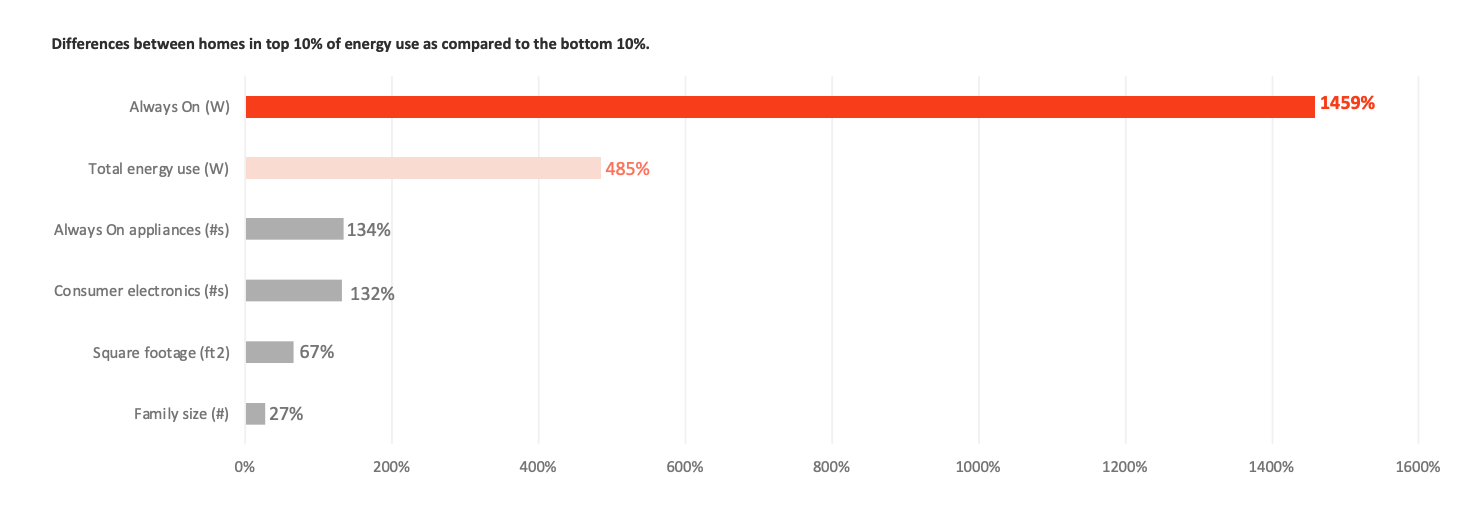This Earth Day, we decided to celebrate by sharing some of the most powerful and unexpected insights the Sense team has gained from your homes. Over the past few years, we’ve analyzed anonymized Sense home data to figure out where the energy hogs are hidden and how homeowners can gain efficiencies. Here’s what we found and why it matters for climate change:
1. Bigger homes waste more energy– and why might surprise you
When Sense analyzed 4,000 Sense homes across North America in 2018, we discovered that a 5,000 square foot home consumes 51% more total energy on average than a 2,500 square feet house and 97% more Always On energy — regardless of family size. The homes that use the most electricity overall — the top 10% — were also the homes that reported the highest numbers of consumer electronics and appliances that run continuously like pool and aquarium pumps and heaters, baseboard heaters, dehumidifiers, hot tubs, fans and security cameras. All those devices humming along add up to a much higher electricity bill and carbon footprint.
How much impact do these homes have? It’s big. If the top 10% of homes (those with highest Always On rates) could reduce their Always On usage to the median of 350W, it would cut overall energy usage in the U.S. by 10%, save $18B annually, and move the country 2% closer to the goals set at the 2015 Paris Climate Agreement. In other words, if you live in a big house with more than 15 gadgets that stay on continuously in the background, your efforts to reduce energy waste could move the needle on climate change in a significant way.
2. You can help prevent blackouts
Prolonged heat waves in California in 2020 made us curious to know whether homeowners could take actions that would reduce load on the grid. In a study of 1100 Sense homes in California, we learned that 55% of electricity usage in the evening time frame, 6 to 8 pm, could be shifted to other times during the day or reduced to help prevent rolling blackouts.

We found that 88% of consumption came from air conditioning systems. The remainder of “shiftable energy” included water heaters, laundry machines (washers and dryers), pool pumps and EV chargers. How can you use this information to help prevent power outages during extreme weather? In a heat wave, consider cooling your home in the afternoon and then turning the AC settings up at 6 pm. Take showers, do laundry and charge your EV at other times of the day or night outside of those crucial evening hours.
3. Your HVAC system could be contributing more to climate change than you think
Our analysis of HVAC systems showed that 20% of Americans have air conditioning that cost the homeowner an extra $882 annually on average to keep their homes cool—almost four times as much as the most efficient similar homes. Why do some homes use more energy to stay cool than others? The culprit could be an inefficient HVAC system or a building envelope that leaks air so your HVAC needs to work harder.
The Sense Home app can tell you if your HVAC system is less efficient than similar homes. If your home is not up to par, schedule an energy audit to find out how to improve. Research your options if you need to invest in a new system. Not only will you save money; the 20% of homes with highest cooling use have a big impact on the nation’s energy picture, accounting for 45% of all cooling consumption nationwide. Updating these least efficient homes could save 8% of US residential electricity usage overall and eliminate nearly 52M tons of CO2 emissions annually.

4. Solar homes can waste energy, too
Most solar homeowners produce more solar energy in the middle of the day but need to use electricity throughout the day and evening. As a result, Sense data showed that more than half (55%) of the electricity generated by solar panels goes back to the utility grid, on average, with less than half (45%) directly used to power the home’s day-to-day needs. We were surprised at this statistic, too!

Above: Solar production is highest at midday but we do a lot of energy intensive activities in the morning and evening hours, when we make meals, stream movies and run appliances like dishwashers. These two curves show summer (left) and winter (right) solar production compared to electricity usage. Note that electricity usage peaks in the evening in the summer.
To take advantage of most of your solar power, schedule appliances during peak solar hours, including your washing machine, dryer, oven, dishwasher, and stove. Charging electric vehicles (EVs) consumes a lot of power, so solar homeowners should make it a priority to charge their EVs during the day using their solar power. If your utility uses time varying rates, it’s even more important to take advantage of your free solar power or consider investing in a battery to store it for later use.
5. Your choices really do matter
We’re returning to our Always On analysis to share insights for every home. For the average home, 23% of electricity goes to devices that keep using energy after they’re turned off. Homeowners pay approximately $308 per U.S. household annually to keep Always On devices running. But it doesn’t have to be that way in your house.
We compared two Sense homes to dig into the differences. The 5000 square foot home had four residents, while the 2,000 square foot home had only two. The real difference is in the electrical devices. The 5000 square foot home had a TV, cable box and streaming device. The 2000 square foot home had four TVs, four cable boxes, and two game consoles.
The big house had a dehumidifier that ran continuously. The smaller house had an aquarium, a fan, servers, instant hot water, pool pump and security camera. The Always On usage in the smaller home with all those devices was 23x that of the bigger home, which helped push its total energy use 450W higher. So at the end of the day, big homes can win when it comes to shrinking your energy footprint! It all comes down to paying attention to your energy usage across the board and keeping it under control.

The real lesson: no matter what your home looks like, the way you live has an impact on climate change. Residential energy use accounts for roughly 20% of greenhouse gas (GHG) emissions in the United States. Understanding your own choices and taking actions to reduce energy usage saves you money and helps the country as a whole move in the right direction on climate change.
At Sense, we’ve been inspired by Rewiring America, whose climate change plan rests on the fundamental premise that we need to electrify everything in order to tap low-carbon energy sources like solar, hydro and wind. In the future, homes won’t have furnaces burning oil or natural gas; instead they’ll rely on solar panels for electricity, heat pumps for cooling and heating, electric vehicles for transportation and low-carbon energy from the utility grid.
And our homes will need to be far smarter than they are today. Most homes were designed for the 20th century, when resources were abundant and climate change was not a threat. But everything has changed. Homes of the future must be radically different — fully connected with energy systems both inside and outside the home, intelligently conserving scarce resources, and using automation to make peoples’ lives better.
Here at Sense, we’re re-inventing the smart home. With our partners, we’re even building Sense technology into the home itself, making it more accessible and convenient. We’re excited about a cleaner, better future, and energized by creating technology for a truly sustainable planet.

